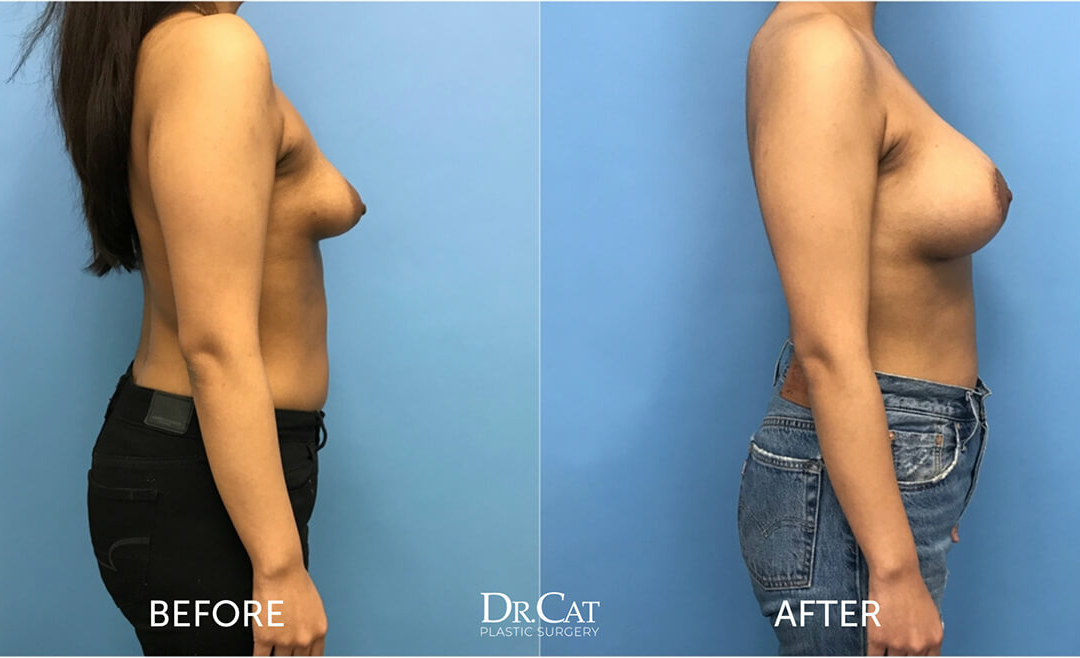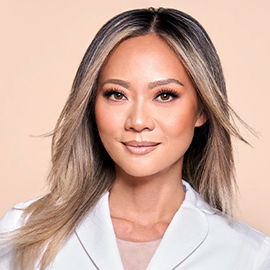If you are suffering from puffy nipples, rest assured, knowing that you aren’t alone. This condition might seem like an unusual occurrence, but the truth is that puffy nipples can happen to both men and women.
What should you do if you think that you have this condition? The best solution is to talk to a doctor to identify the underlying condition. If you want to improve your appearance, there are several things you can do to reduce puffiness.
Causes of Puffy Nipples
One of the first questions people ask when they have this condition is why their nipples are puffy. Usually, this condition happens because of enlarged breast glands, and there are a variety of factors that can contribute to causing the increase in breast gland size:
- Genetics: As with many other health issues, genetics often play a role. Certain people have a higher risk of developing puffiness in their nipple area because of their genes.
- Hormones: When the hormones start to change, these adjustments can cause different symptoms in the body – including puffy nipples. For example, women might experience puffiness during their menstrual cycle or while pregnant. For men, low testosterone can be a factor that increases the risk.
- Gynecomastia: Men can have a specific type of hormone imbalance known as gynecomastia, which often causes puffy nipples.
- Puberty: Hormones are in flux during puberty, and some teenagers experience puffy nipples in this stage of life. Often, the condition will normalize as they reach the end of puberty. So, there is no reason for concern.
- Body Fat: An increase in body fat can influence the development of puffy nipples, especially in men. Patients who experience drastic weight changes have a higher risk of this condition.
- Medications: Certain medications cause inflammatory responses, which might result in puffiness in the nipple area and other parts of the body.
- Steroids and Recreational Drugs: Men using steroids have a higher risk of developing puffy nipples. Additionally, there are suggestions that cannabis use could increase the risk of enlarged male breasts.
How to Tell If You Have Puffy Nipples
The appearance of the nipples is the telling symptom that you have this condition. Most patients don’t have any other corresponding symptoms.
You will notice that the nipple mound is formed away from the typical curve of the chest. For women, the nipple will appear herniated, cone-shaped, or pointy.
Cosmetic Surgery to Correct Puffy Nipples
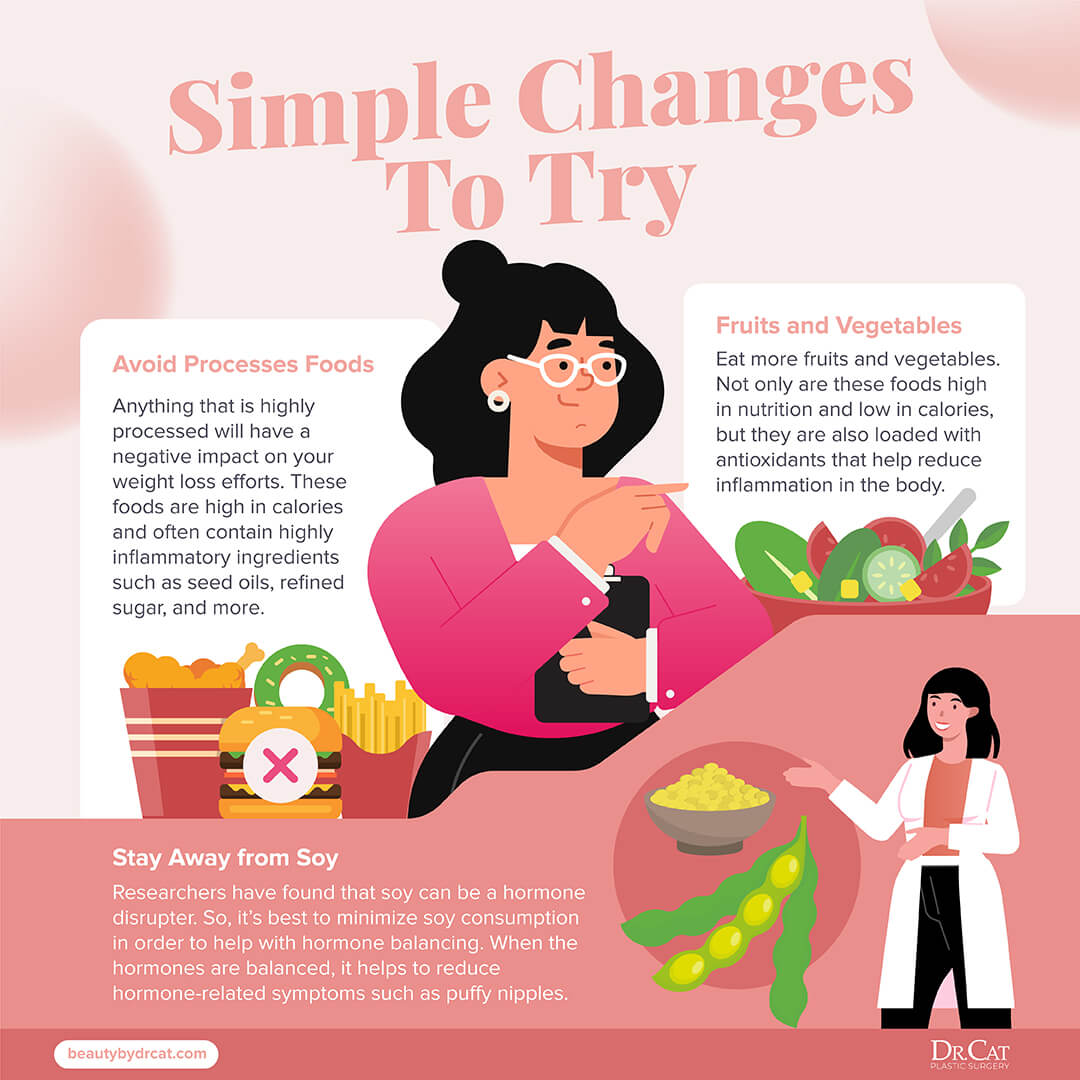
If you have tried other non-invasive remedies at home and still aren’t seeing the desired results, it might be time to talk to a plastic surgeon about surgical treatments. While diet and exercise might make a small difference in reducing the appearance of puffy nipples, surgery is often the most effective solution.
The first step is to schedule a consultation with a board-certified plastic surgeon to determine if you are a good candidate for this procedure. Make sure you are working with a doctor who has experience treating gynecomastia as well as puffy nipples caused by other health conditions.
Tuberous Breast Correction: The exact surgical treatment will vary depending on your unique needs. In most situations, patients benefit from Tuberous Breast Correction surgery, gynecomastia surgery, mastectomy, or subcutaneous mastectomy, liposuction, and vreast enhancement surgeries. For example, breast enhancement surgery can improve the appearance of puffy nipples because the surgeon reshapes the breasts using implants, which can help to smooth out the overall appearance.
During the surgery, incisions are made around the areola and then the internal fibers are adjusted and reshaped. Additionally, excess breast skin can be removed and the breast is re-shaped and re-sized with an ideal contour and appearance. Once the implant is in place and the breast heals, then the nipple ratio and alignment look better.
Keep in mind that basic breast augmentation isn’t enough to entirely modify tuberous breasts or puffy nipples. It’s also necessary to adjust and release the connective tissues to achieve surgical success. This puffy nipple correction surgery can be done with or without a breast lift surgery, depending on the severity of the situation and each patient’s individual needs.
Mastectomy: Another way that cosmetic surgery can help with puffy nipples is through a procedure called mastectomy or subcutaneous mastectomy. This procedure is designed to remove excess glandular tissue and reshapes the nipple and areola complex to achieve a flatter and more appealing appearance. Liposuction is many times combined with this or another procedure to remove any additional fat deposits and contour the chest area. The overall result should be a more balanced and natural-looking chest.
Gynecomastia: Gynecomastia surgery is another popular procedure aimed at addressing the excess glandular tissue and fat in the chest area, which can lead to the appearance of enlarged and puffy male breasts. This surgery can be an effective solution for individuals struggling with self-consciousness and discomfort associated with gynecomastia. More than 20,000 people get this surgery every year.
World-renowned plastic surgeon, Dr. Cat Begvoic, understands the importance of her patients feeling comfortable and confident throughout their puffy nipple procedure. Her gentle and meticulous surgical technique results in little to no pain and barely visible scars. This means that patients can have a quick recovery and get back to their busy lives. It’s important to trust an expert female surgeon like Dr. Cat for this procedure, as her approach is tailored specifically to the needs and concerns of her patients.
Dr. Cat even has patients coming for surgery to fix or repair “botched” work from another surgeon. This surgery requires advanced skills in cosmetic and reconstructive surgical methods, and Dr. Cat is widely known as one of the leading providers of breast surgery. Always make sure you choose a reputable surgeon, such as Dr. Cat, when you are investing in cosmetic services.
Do Natural Remedies Help with Puffy Nipples?
There is a lot of information online about diet and exercise techniques that might help to reduce puffy nipples. But the truth is that these at-home remedies usually aren’t effective. But it doesn’t hurt to improve your health through diet and exercise to see if it has a positive impact to reduce puffy nipples. So, this article will share more information about options that might be considered.
If you want to improve the appearance of your nipples and get rid of puffiness, then it might be time to schedule a consultation with a doctor who understands this condition. The first goal is to determine the underlying cause, then a treatment plan can be designed based on your unique needs.
Lifestyle Changes to Reduce Puffy Nipples
 If you want to reduce the appearance of puffy nipples, it’s important to identify the root cause. Resolving this base issue might help to correct any corresponding symptoms.
If you want to reduce the appearance of puffy nipples, it’s important to identify the root cause. Resolving this base issue might help to correct any corresponding symptoms.
For example, suppose you are carrying excess body weight. In that case, diet and exercise can be helpful in reducing weight – which can have a positive impact on decreasing the appearance of puffy nipples.
Targeted Exercises
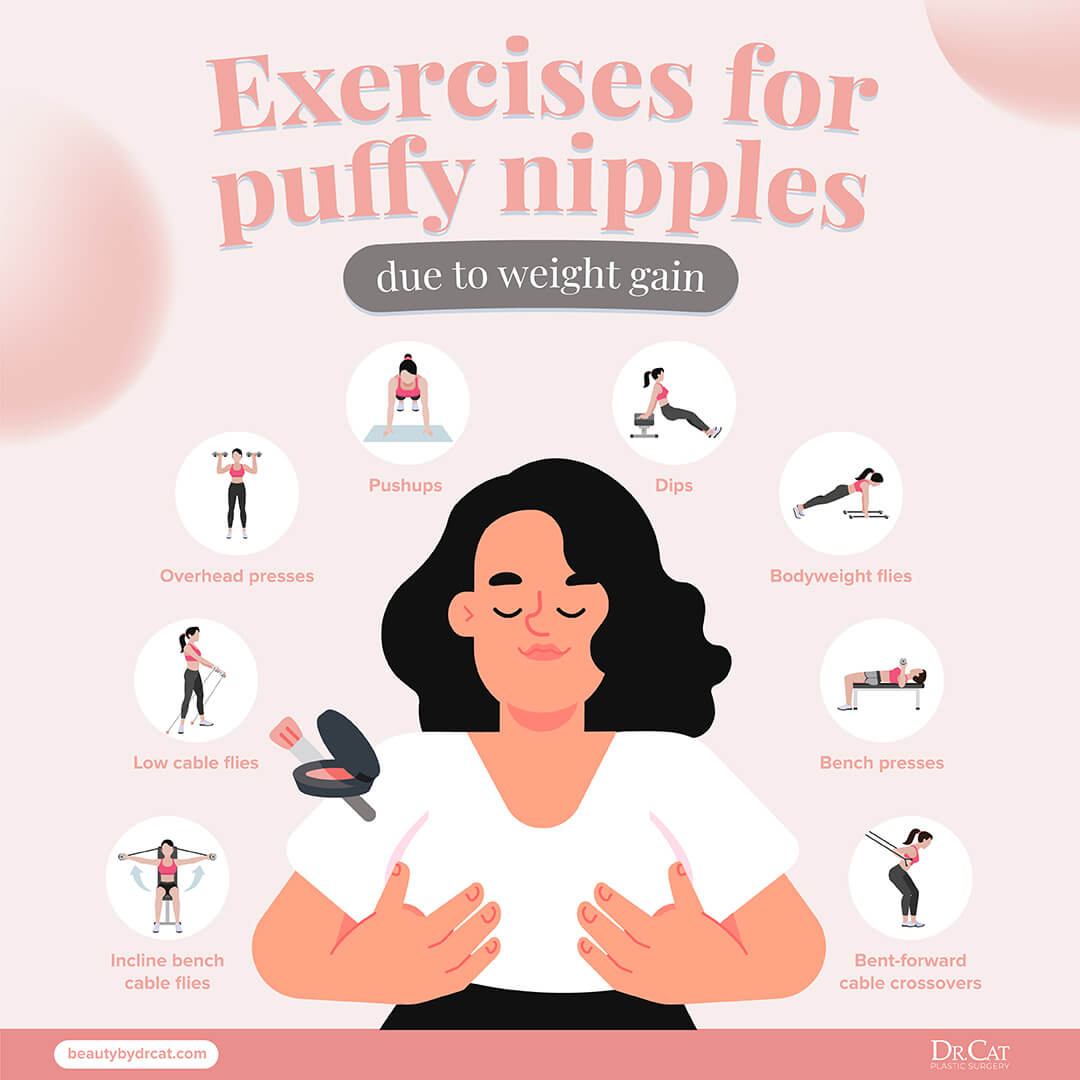
One way to reshape the pectoral area is by doing chest exercises to target this specific part of the body. The goal is to tone and tighten the chest and pectoral muscles.
Here are exercises that might help:
- Overhead presses
- Pushups (regular, diamond, and suspended)
- Overhead presses
- Incline bench cable flies
- Low cable flies
- Bodyweight flies
- Bench presses (barbell, incline, and decline)
- Bent-forward cable crossovers
- Dips
The best solution is to work with a personal trainer for a customized workout plan. Make sure you are training these chest muscles at least 2 – 3 times per week, but don’t overdo it.
Try switching up the repetitions and sets to avoid hitting a plateau with your muscle growth. Here are a few examples of different types of sets and repetitions you can put into your workout plan:
- 1 – 3 sets, with 8 – 12 repetitions per set
- 2 – 6 sets, with 1 – 8 repetitions per set
Each time you do a chest workout, aim for a 20-minute session. Over time, you will build strength and be able to increase the repetitions, weight, frequency, and duration. Make sure you are rotating through different exercises so that you are getting slight changes in the way you are working the muscles.
Cardio
Targeted exercises are helpful for training the muscles. At the same time, it’s important that you get in cardio workouts several times a week.
When you do cardio, such as cycling, running, swimming, dancing, etc., it helps to boost the metabolism so you can burn fat more effectively. Not only will you lose fat throughout the body, but it can also help to decrease fat in the chest area, which might help to reduce the appearance of puffy nipples.
Some of these cardio exercises, such as rowing and swimming, target the chest and shoulder muscles while working out.
With any exercise routine, including weight training and cardio, it’s essential to ensure you are planning a rest day. The muscles need time for recovery before you work them out again.
Dietary Changes
Your food choices play a role in body fat and even estrogen levels. Making a few dietary changes can have a position impact on helping you improve your fitness and stay in shape.
A few simple changes to make include:
- Fruits and Vegetables: Eat more fruits and vegetables. Not only are these foods high in nutrition and low in calories, but they are also loaded with antioxidants that help reduce inflammation in the body.
- Avoid Processed Foods: Anything that is highly processed will have a negative impact on your weight loss efforts. These foods are high in calories and often contain highly inflammatory ingredients such as seed oils, refined sugar, and more.
- Stay Away from Soy: Researchers have found that soy can be a hormone disrupter. So, it’s best to minimize soy consumption in order to help with hormone balancing. When the hormones are balanced, it helps to reduce hormone-related symptoms such as puffy nipples.
Keep in mind that each person’s dietary requirements are unique. The specific foods and amount of food you should be eating depends on a variety of factors, including age, activities, health concerns, and more.
If you suspect that your hormone levels are the cause of your nipple symptoms, then look for ways to add these hormone-balancing foods into your diet:
- Blueberries
- Beans
- Milk
- Tuna
- Ginger
- Garlic
- Oysters
- Shellfish
- Macadamia nuts
- Cruciferous vegetables
- Egg yolks
Also, don’t underestimate the benefit of talking to a doctor. If hormones are the issue, you can get testing done to determine what is happening with your hormones. There might be other dietary and lifestyle adjustments you can make for hormone balancing based on your unique needs.
Can Herbal Supplements Help with Puffy Nipples?
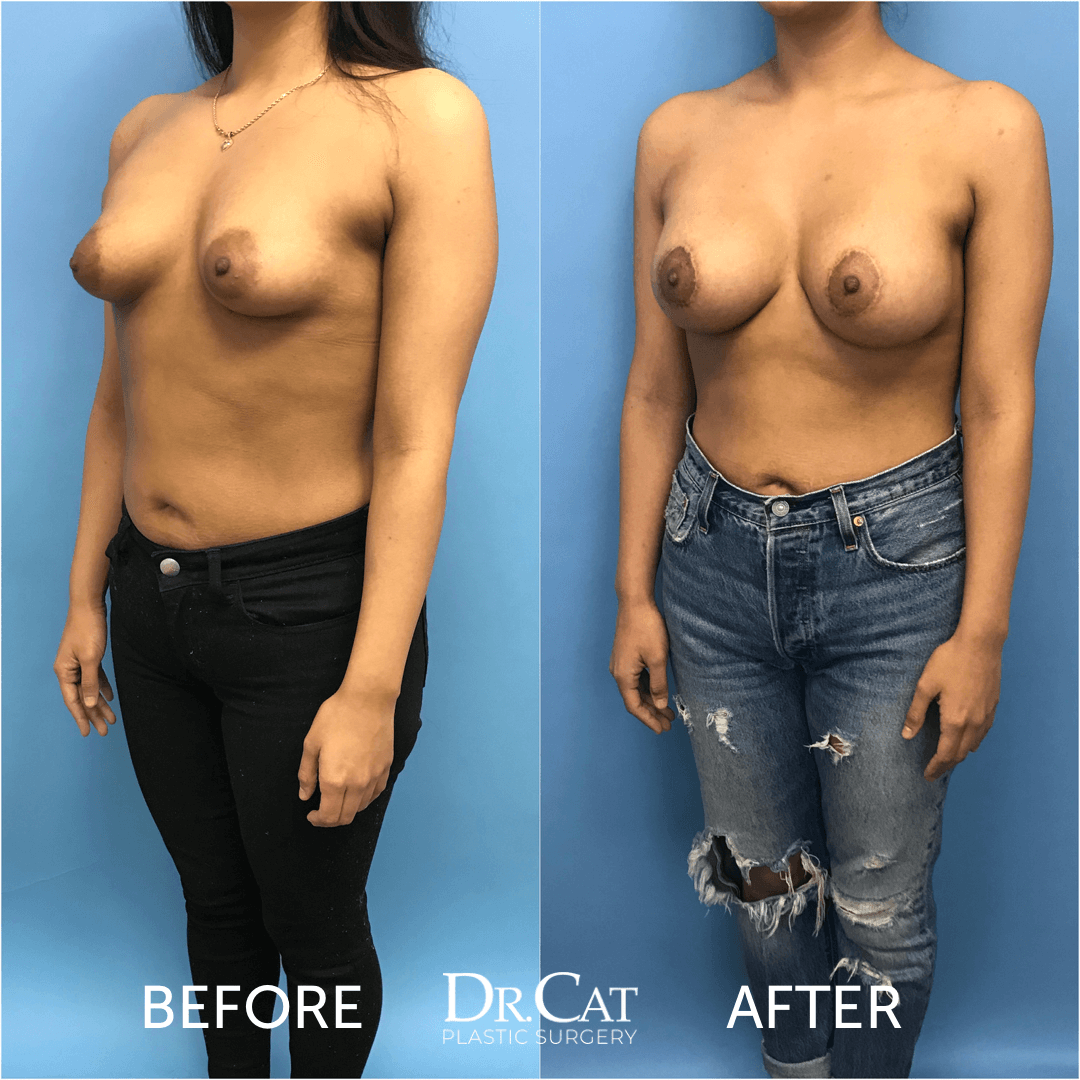 One natural option to balance the hormones and possibly improve the appearance of puffy nipples is by using herbal supplements. There are a few things that you can find at the health food store that are said to help with increasing testosterone levels – which is an important part of helping men reduce the risk of puffy nipples:
One natural option to balance the hormones and possibly improve the appearance of puffy nipples is by using herbal supplements. There are a few things that you can find at the health food store that are said to help with increasing testosterone levels – which is an important part of helping men reduce the risk of puffy nipples:
- Ashwagandha
- Tribulus Terrestris
- Ginger
- Fenugreek
Keep in mind that these herbal supplements need more research to determine the exact impact that they have on testosterone levels. Early evidence shows that they can help boost testosterone and help men with conditions like erectile dysfunction, but research is needed to determine how the supplements affect puffy nipples.
Even though there isn’t scientific evidence that these supplements impact puffy nipples, there is evidence that they help with testosterone boosting.
A few other anecdotal evidence shows that there are a few other herbs that could have a positive impact on reducing puffy nipples, including:
- Red clover
- Turmeric
- Passionflower
- Devil’s claw
- Dandelion
- Milk thistle
Keep in mind that you should always consult with a doctor when starting new supplements or changes in your lifestyle. Even though supplements come from natural sources, there are still potential side effects that could be dangerous to your health. For example, there could be a possibility of supplements interacting with prescription medications that you are using.
So, consult with your doctor to evaluate individual risks and determine if there is anything that you need to be aware of in your own medical history. Your doctor might be able to suggest a specific brand to use, as well as dosage suggestions.
Also, when you are buying supplements, ensure that they are coming from a trusted source. The quality of the supplements matters. Unfortunately, there are many products out there that are adulterated and contain ingredients that aren’t listed on the label.
Supplements can be controversial, especially since they aren’t approved or monitored by the FDA. So, this at-home remedy should be evaluated on an individual basis. Most people don’t achieve the results they desire through supplements and choose to explore surgical options for real results.
Call for a Consultation with Dr. Cat
The fastest way to improve the appearance of puffy nipples is through surgery. For more information about this treatment, reach out to a world-renown expert: Dr. Cat Begovic.
Dr. Cat has an excellent reputation in the industry as the best plastic surgeon in the world. In addition to nipple surgery, she also offers a variety of other cosmetic treatments to help you achieve your best self.
Rest assured in the quality of treatment. Dr. Cat is board-certified and has years of experience working with many different patients from all over the world. Call Dr. Cat’s office at your convenience to book a consultation and determine the best treatment for your unique needs. You can also book a pre-phone consultation to answer general questions by using this link.
